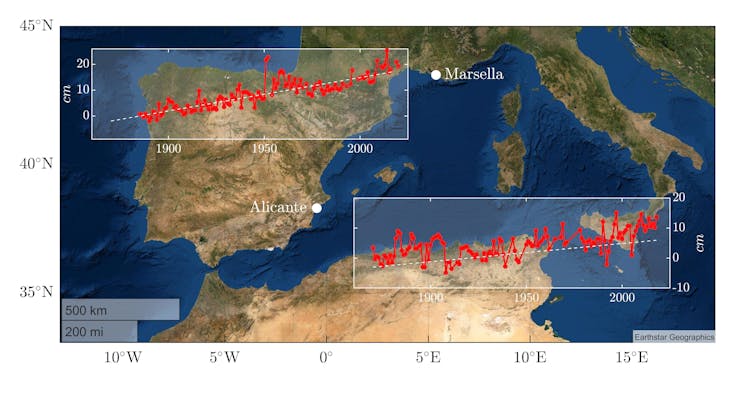In the Mediterranean, the sea level has risen 16 cm since there are records and half of them only in the last 30 years
Marta Marcos, University of the Balearic Islands
The Mediterranean coast is an area particularly vulnerable to climate change. Its high coastal population density (34% against 10% globally) and its economy based mainly on sun and beach tourism have encouraged coastal urbanization. Once anthropogenic, these coasts are more vulnerable to rising sea levels and are increasingly facing floods and erosion that put the population and infrastructure at risk.
The causes of sea level rise
20,000 years ago, when the homo sapiens it was still a hunter-gatherer species, the surface of the oceans was about 120 m below its current level. The reason is that much of the water that now forms part of the oceans was ice back then. These large ice caps were slowly reduced by natural processes to their current extent and, like climatic conditions, remained stable for approximately 10,000 years.
During this period, called the Holocene, human civilization developed, largely favored by conditions of climatic stability. It is not surprising, therefore, that we have considered our coasts as static lines, where the sea level has remained practically unchanged for millennia, to the point that today the regions close to the sea concentrate, in relative terms, most of the human population. .
With global warming derived from the emission of greenhouse gases into the atmosphere, the planet is undergoing changes in its climatic conditions of unprecedented magnitude and speed in hundreds of thousands of years.
One of these palpable and potentially most damaging changes is sea level rise. Globally, the sea level rises for two reasons: first, due to the warming of the oceans, which expand, accumulating the heat resulting from the absorption of more than 90% of the extra energy of global warming. Second, by the loss of continental ice, both from mountain glaciers and from the polar layers, which, when melting, add more water to the oceans.
Average, sea level has risen by about 20 cm since the beginning of the 20th century, of which 8 cm were in the last 30 years. That is, not only is it increasing, but it is also accelerating the speed at which it happens.
When sea level rises, the configuration of the shores changes, but not everywhere. To begin, sea level changes are not homogeneous across the planet, mainly due to regional differences in heat absorption and ocean circulation.
In some regions, sea levels can rise up to 30% more than the global average. Furthermore, not all coasts respond in the same way to a change in position at ocean level. For example, low-lying coastal areas such as river deltas can be permanently flooded; In contrast, sedimentary shores respond dynamically, while corals grow vertically when the water column that covers them does.
How much has increased since records exist?
Our witnesses are some of the oldest environmental records, obtained from tide gauge observations. A tide gauge is an instrument anchored on the shore that continuously measures changes in sea level against a fixed reference.
Some of the longest time series of data are found in the Mediterranean Sea, such as Marseille and Alicante, whose measurements start in the 19th century (see Figure).
Source for Marseille series: Permanent Service for Medium Sea Level (www.psmsl.org) / Source for Alicante series: (Marcos et al., 2021)
In the Mediterranean, the sea level has risen 16 cm since there are records and half of them only in the last 30 years. As a result of these changes, the coasts of the Mediterranean have been eroded and regressed 0.5 m / year since the 80s of the last century.
Sea levels will continue to rise for decades and centuries. O climate models that represent possible future climate scenarios on the planet indicate that, assuming a drastic reduction in emissions (compatible with a global temperature increase of 1.5 ℃ compared to the pre-industrial era – let us not forget that we have already reached 1.2 ℃ – ), sea level at the end of this century will be almost 40 cm above what we had at the beginning of the 21st century.
In a more negative scenario, with temperature increases of up to 5 ℃, this value would likely be at least 80 cm. And what is more shocking is that, due to possible instabilities in the Antarctic ice sheet, with such an increase in global temperature, values of 1.5 m by the end of the century, 2 m by the middle of the next century and upwards to 10 m until the year 2300.
The implications of such a change would be enormous for all coastal areas in the world, including the complete submergence of large urban areas in the long term.

Shutterstock / anek.soowannaphoom
The disappearance of Mediterranean beaches
In an environment as sensitive to rising sea levels as the Mediterranean, the consequences will be visible in the coming decades. Coasts are increasingly vulnerable to the impacts of extreme floods. With higher sea levels, the magnitude and frequency of extreme events will increase and what is now a rare event that occurs once every 100 years, by mid-century it will be observed every 5 years and by the year 2100 it will be something common this will happen several times a year. Coastal erosion will also worsen, with average setbacks between 50 m and 80 m, depending on the climate scenario.
This effect will translate into the disappearance of most beaches in the Mediterranean, especially urban and highly anthropogenic ones that do not have enough space to move inland as sea levels rise, with the impact this has on savings. coastal tourism.
Some of the consequences of rising sea levels are at this point unavoidable, as some of the future changes are compromised by past and current emissions. However, the full magnitude of the changes and the speed with which they occur depend on actions and emissions today and in the coming decades. Our actions can make the difference between the ability or not to adapt to a new configuration of our coasts and the irreversible loss of currently densely populated regions.![]()
Marta Marcos, Researcher at IMEDEA (CSIC – UIB) and Professor at the University of Earth Physics, University of the Balearic Islands
This article was originally published in The conversation. read the original.

